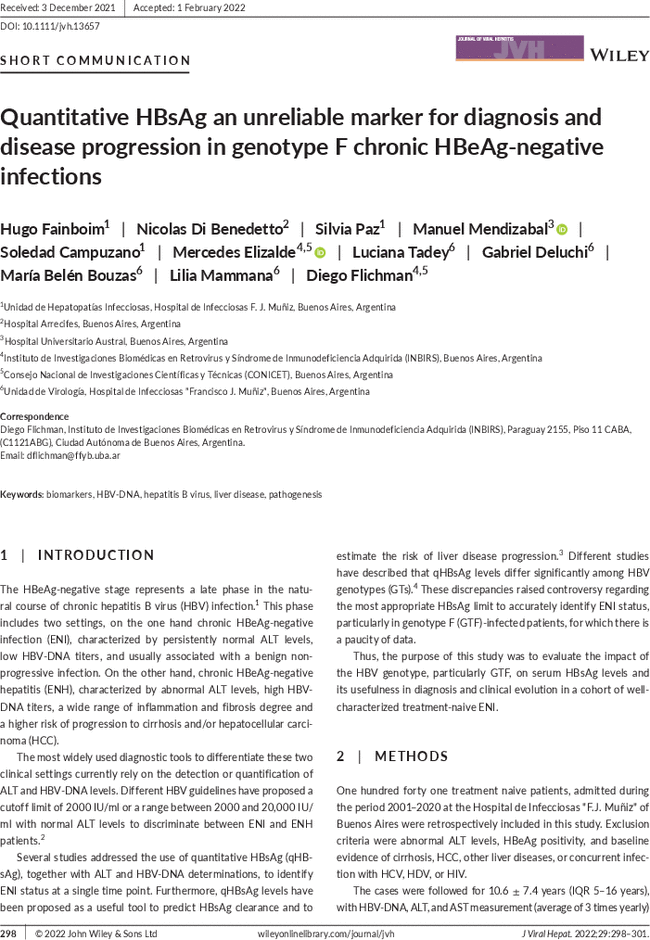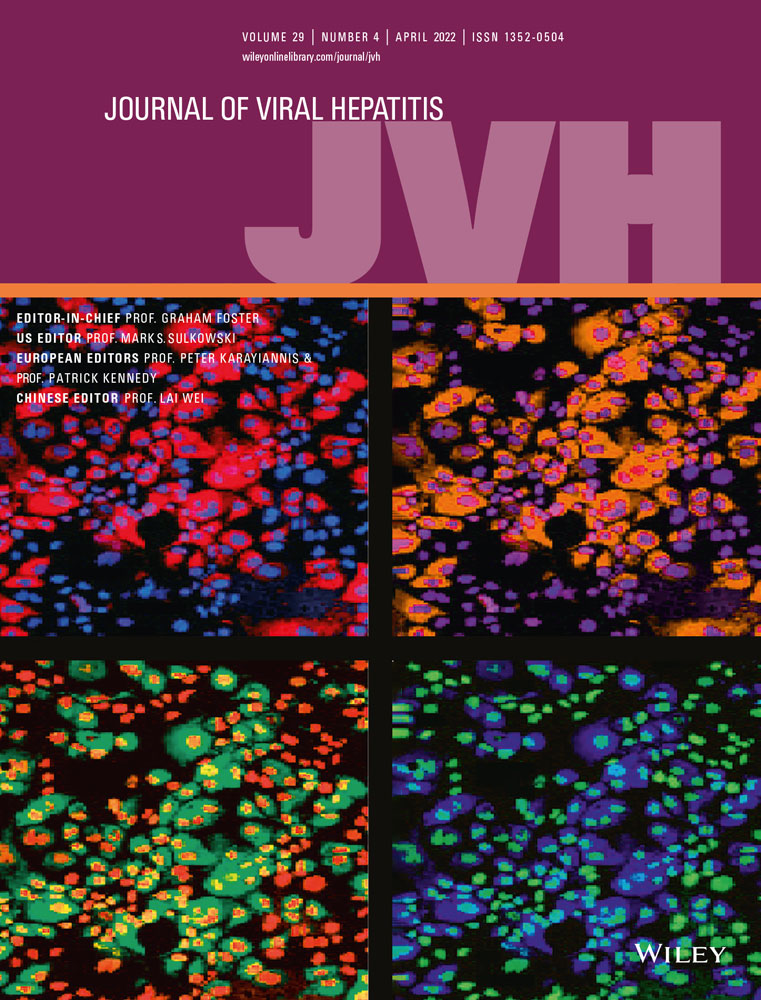Quantitative HBsAg an unreliable marker for diagnosis and disease progression in genotype F chronic HBeAg-negative infections
Hugo Fainboim
Unidad de Hepatopatías Infecciosas, Hospital de Infecciosas F. J. Muñiz, Buenos Aires, Argentina
Search for more papers by this authorNicolas Di Benedetto
Hospital Arrecifes, Buenos Aires, Argentina
Search for more papers by this authorSilvia Paz
Unidad de Hepatopatías Infecciosas, Hospital de Infecciosas F. J. Muñiz, Buenos Aires, Argentina
Search for more papers by this authorManuel Mendizabal
Hospital Universitario Austral, Buenos Aires, Argentina
Search for more papers by this authorSoledad Campuzano
Unidad de Hepatopatías Infecciosas, Hospital de Infecciosas F. J. Muñiz, Buenos Aires, Argentina
Search for more papers by this authorMercedes Elizalde
Instituto de Investigaciones Biomédicas en Retrovirus y Síndrome de Inmunodeficiencia Adquirida (INBIRS), Buenos Aires, Argentina
Consejo Nacional de Investigaciones Científicas y Técnicas (CONICET), Buenos Aires, Argentina
Search for more papers by this authorLuciana Tadey
Unidad de Virología, Hospital de Infecciosas "Francisco J. Muñiz", Buenos Aires, Argentina
Search for more papers by this authorGabriel Deluchi
Unidad de Virología, Hospital de Infecciosas "Francisco J. Muñiz", Buenos Aires, Argentina
Search for more papers by this authorMaría Belén Bouzas
Unidad de Virología, Hospital de Infecciosas "Francisco J. Muñiz", Buenos Aires, Argentina
Search for more papers by this authorLilia Mammana
Unidad de Virología, Hospital de Infecciosas "Francisco J. Muñiz", Buenos Aires, Argentina
Search for more papers by this authorCorresponding Author
Diego Flichman
Instituto de Investigaciones Biomédicas en Retrovirus y Síndrome de Inmunodeficiencia Adquirida (INBIRS), Buenos Aires, Argentina
Consejo Nacional de Investigaciones Científicas y Técnicas (CONICET), Buenos Aires, Argentina
Correspondence
Diego Flichman, Instituto de Investigaciones Biomédicas en Retrovirus y Síndrome de Inmunodeficiencia Adquirida (INBIRS), Paraguay 2155, Piso 11 CABA, (C1121ABG), Ciudad Autónoma de Buenos Aires, Argentina.
Email: [email protected]
Search for more papers by this authorHugo Fainboim
Unidad de Hepatopatías Infecciosas, Hospital de Infecciosas F. J. Muñiz, Buenos Aires, Argentina
Search for more papers by this authorNicolas Di Benedetto
Hospital Arrecifes, Buenos Aires, Argentina
Search for more papers by this authorSilvia Paz
Unidad de Hepatopatías Infecciosas, Hospital de Infecciosas F. J. Muñiz, Buenos Aires, Argentina
Search for more papers by this authorManuel Mendizabal
Hospital Universitario Austral, Buenos Aires, Argentina
Search for more papers by this authorSoledad Campuzano
Unidad de Hepatopatías Infecciosas, Hospital de Infecciosas F. J. Muñiz, Buenos Aires, Argentina
Search for more papers by this authorMercedes Elizalde
Instituto de Investigaciones Biomédicas en Retrovirus y Síndrome de Inmunodeficiencia Adquirida (INBIRS), Buenos Aires, Argentina
Consejo Nacional de Investigaciones Científicas y Técnicas (CONICET), Buenos Aires, Argentina
Search for more papers by this authorLuciana Tadey
Unidad de Virología, Hospital de Infecciosas "Francisco J. Muñiz", Buenos Aires, Argentina
Search for more papers by this authorGabriel Deluchi
Unidad de Virología, Hospital de Infecciosas "Francisco J. Muñiz", Buenos Aires, Argentina
Search for more papers by this authorMaría Belén Bouzas
Unidad de Virología, Hospital de Infecciosas "Francisco J. Muñiz", Buenos Aires, Argentina
Search for more papers by this authorLilia Mammana
Unidad de Virología, Hospital de Infecciosas "Francisco J. Muñiz", Buenos Aires, Argentina
Search for more papers by this authorCorresponding Author
Diego Flichman
Instituto de Investigaciones Biomédicas en Retrovirus y Síndrome de Inmunodeficiencia Adquirida (INBIRS), Buenos Aires, Argentina
Consejo Nacional de Investigaciones Científicas y Técnicas (CONICET), Buenos Aires, Argentina
Correspondence
Diego Flichman, Instituto de Investigaciones Biomédicas en Retrovirus y Síndrome de Inmunodeficiencia Adquirida (INBIRS), Paraguay 2155, Piso 11 CABA, (C1121ABG), Ciudad Autónoma de Buenos Aires, Argentina.
Email: [email protected]
Search for more papers by this author
CONFLICT OF INTEREST
The authors have no conflicts of interest to declare.
REFERENCES
- 1Likhitsup A, Lok AS. Understanding the natural history of hepatitis B virus infection and the new definitions of cure and the endpoints of clinical trials. Clin Liver Dis. 2019; 23: 401-416.
- 2 European Association for the Study of the Liver. Electronic address: [email protected]; European Association for the Study of the Liver. EASL 2017 clinical practice guidelines on the management of hepatitis B virus infection. J Hepatol. 2017; 2017(67): 370-398.
- 3Cornberg M, Wong VW, Locarnini S, Brunetto M, Janssen HLA, Chan HL. The role of quantitative hepatitis B surface antigen revisited. J Hepatol. 2017; 66: 398-411.
- 4Kuhnhenn L, Jiang B, Kubesch A, et al. Impact of HBV genotype and mutations on HBV DNA and qHBsAg levels in patients with HBeAg-negative chronic HBV infection. Aliment Pharmacol Ther. 2018; 47: 1523-1535.
- 5Liu J, Yang HI, Lee MH, et al. Serum levels of hepatitis B surface antigen and DNA can predict inactive carriers with low risk of disease progression. Hepatology. 2016; 64: 381-389.
- 6Ledesma MM, Galdame O, Bouzas B, et al. Characterization of the basal core promoter and precore regions in anti-HBe-positive inactive carriers of hepatitis B virus. Int J Infect Dis. 2011; 15: e314-e320.
- 7Riveiro-Barciela M, Bes M, Rodríguez-Frías F, et al. Serum hepatitis B core-related antigen is more accurate than hepatitis B surface antigen to identify inactive carriers, regardless of hepatitis B virus genotype. Clin Microbiol Infect. 2017; 23: 860-867.
- 8Tseng TC, Liu CJ, Su TH, et al. Serum hepatitis B surface antigen levels predict surface antigen loss in hepatitis B e antigen seroconverters. Gastroenterology. 2011; 141: 517-525.e2.




